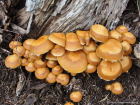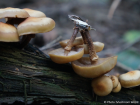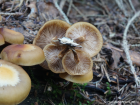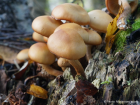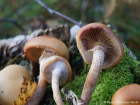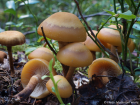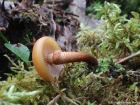Cap convex, becoming broadly convex or nearly flat, and hygrophanous which means it is changing colour as it dries out and fading from tawny to orangish brown to yellowish or brownish (often passing through a two-toned stage). The cap flesh is pale tan, quite thin and unchanging when sliced. Gills adnate (broadly attached to the stem) and crowded, whitish to pale tan when young, becoming cinnamon brown as the spores mature. Stem pale and smooth above the fairly persistent stem ring, fibrous, scaly and dark tan below, graduating to almost black at the base. Spore print cinnamon brown.
Microscopic Features: The spores of the mushroom are broadly ellipsoidal, and smooth, measuring approximately 5.5-7.5 x 4-5µm. They possess an apical germ pore.
Similar species include Galerina marginata (Deadly Galerina).
Kuehneromyces mutabilis on the First Nature Web site.
Kuehneromyces mutabilis on the MushroomExpert.Com Web site.
Many mushrooms are poisonous, and some can be lethally toxic. Distinguishing between edible and poisonous mushrooms can be very challenging. Therefore, we strongly advise against consuming wild mushrooms. This website does not contain any information about the edibility or toxicity of mushrooms.
Although efforts have been made to ensure accuracy on this website, the information may contain errors and omissions. Therefore, all content provided is for educational and informational purposes only and should not be relied upon or used as a basis for consuming any plants or mushrooms.
External links are provided for reference only. We do not endorse or take responsibility for the content, advice, or products found on these sites or in any advertisements shown on this website.
